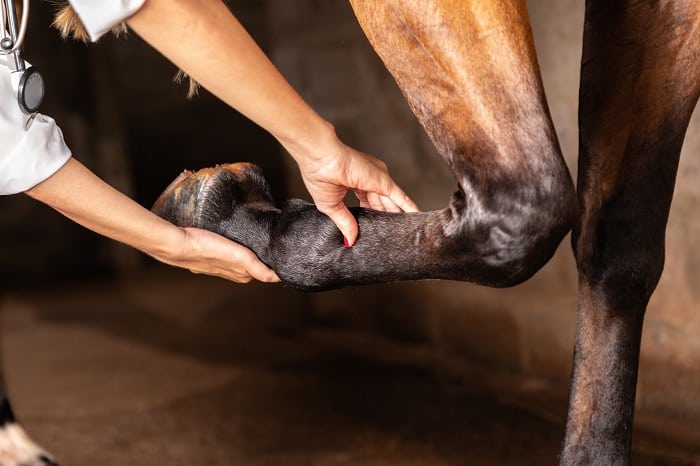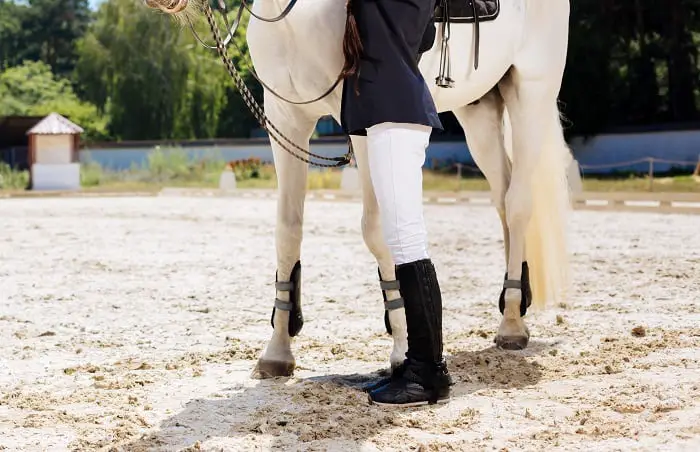Last Updated on November 25, 2021
One of the most dreaded injuries a sport horse can incur is a bowed tendons in horses. Sport horse owners dread the day when the vet gives their horse this diagnosis. Questions immediately follow: can it be fixed? Will my horse show again? And the answer, as always, is that it depends.
Bowed tendon injuries used to mean the end of a horse’s career. But, with today’s more advanced technologies and veterinary research, it is possible for horses to recover from bowed tendons. But, it is still a difficult process, and it is one that you must take with both your horse and your vet by your side.
In this article, I’ll be discussing what bowed tendons are, what causes them, how to treat them, what recovery from bowed tendons can look like, and how to prevent bowed tendons.
What is a Bowed Tendon?
According to the American Association for Equine Practitioners, a bowed tendon is when a horse has suffered, “the tearing of the superficial digital flexor tendon in the middle of the cannon bone region. This tear causes a curved, bow-like swelling on the back of the leg between the knee and the ankle. Although the swelling is usually in the middle of the cannon bone, it may be behind the knee, at the level of the ankle, or it may extend from the knee to the pastern.”
It is similar to a person tearing an ACL, MCL, or meniscus in their knee. The pain is severe, and the recovery process can be long and trying.
Causes of Bowed Tendons
While there are certain types of horses and certain disciplines that statistically produce more bowed tendons, every horse participating in any type of physical activity is at risk of a bowed tendon. The same way that football players and cross country runners are statistically more likely to tear their ACL than I am while taking my dog for a walk.
Bowed tendons can occur suddenly during exercise, and they can gradually build up over time. The causes of bowed tendons come down to over-exertion and flexion in that tendon.
For example, if a showjumper stretches too far to clear an oxer out of a long-distance, and then lands (therefore applying pressure) the already stretched tendon, this could cause a bowed tendon.
Or, a racehorse that runs the same track, in the same direction, every day, could develop a bowed tendon from over-exerting the same leg and tendons around the corners every day.
Treatment for Bowed Tendons
Similar to many equine injuries and illnesses, there is no magic cure that will make a bowed tendon go back to normal. In fact, a bowed tendon will never go back to normal. Once it has been stretched, it will never retain its original size and shape.
But, there are ways to treat bowed tendons to help your horse become comfortable after his injury, though your horse may not like these methods. The best thing you can do for a horse with a bowed tendon is to let him rest.
This means no exercise, no turnout, barely even hand-walking. Horses with bowed tendons need to be put on stall rest for a long amount of time, to allow the tendon to try to heal itself. From there, your vet will develop a rehabilitation plan with you, for your horse.
These rehabilitation plans look like lots of hand walking in small increments, slowly, over months and months, building up to maybe a few minutes of trot work. Then again in a few months, maybe some canter work.
It can take over a year for a horse to fully come back from a bowed tendon if it is possible for them to come back at all.
Recovery from Bowed Tendons- Is It Possible?
Thankfully, it is possible for a horse to recover from a bowed tendon. But let me be very clear- it won’t happen in every case. Sometimes horses will not be sound again after sustaining a bowed tendon.
Sometimes, the horse will come back from rehabilitation sound, but unable to compete at the level they were once able to. These horses may need a career change, or even just a lower level to compete at.
Miraculously in this day and age, sometimes horses will make a full recovery! It is possible, thanks to technology and advanced veterinary research, that a horse that sustains a bowed tendon can make a full recovery, and resume competing at the same level he was when he sustained the injury.
Preventing Bowed Tendons
Bowed tendons are scary, and although it is possible, there is no promise that they can be completely healed. We all want what is best for our four-legged partners, and as such, there are some preventative measures that we can take in order to protect our horses from bowed tendons.
First, monitor and adjust your sport horses’ training program. Every horse is different and can handle different things. But make sure you aren’t doing the same thing every day. Shake things up, make some days harder than others, etc.
Even Olympic level show jumpers don’t need to jump every day. In fact, these horses frequently only jump once or twice a week. And, they only jump “to height” (i.e.- the height they jump in the show ring) right before they go to shows. Olympic riders know that they have to save their horse’s legs if they want to have successful careers.
Second, use protective “tendon boots” on your horse. All disciplines of sport horses (eventers, show jumpers, dressage horses, racehorses, reiners, barrel racers, etc.) can be seen wearing polo wraps, splint boots, and other protective boots on their legs, between their canon bone and their fetlock.
These boots can help give horses extra support in these areas of their legs, preventing some of the physical impact and strain from being inflicted on their tendons and muscles.
Conclusion
Bowed tendons can be very scary. Thankfully today, horses can recover from them, and there are things that can be done to prevent them. I hope this article helped you learn more about bowed tendons in horses! If so, please share it, and share with us your experiences dealing with bowed tendons!
FAQs
Are bowed tendons painful for a horse?
Bowed tendons in horses can be in varying levels of severity and in most cases the horse will learn to adapt and compensate for this. Bowed tendon is a condition where the tendon has been pulled away from its attachment on the bone, usually due to strain on the tendon.
Bowed Tendons in horses can be painful or they might not even be noticed. They are usually a result of injury or abnormal stress on the tendon. They can also be caused by a previous fracture, where part of the broken bone has caused an over pull of the tendon. As well as being pulled away from it's attachment to a bone a bowed tendon can also become eroded and damaged.
How do horses compensate for bowed tendon?
Compensation is when one structure in the body adapts to make up for another and it usually occurs in the case of bowed tendons in horses.
Horses can compensate for bowed tendons in a number of different ways. The main way is by laminitis and/or splints which can appear due to the strain on the tendon and also be caused directly from the injury itself. Bowed tendons may be painful and the horse will not want to use that leg, this is when it will compensate by using another one instead. Bowed tendons in horses can be self-limiting which means that the horse will adapt over time. Bowed tendons are not usually life threatening to a horse but they can cause problems for the animal long after the initial injury has occurred.
How do you know if a horse has bowed tendons?
There are a number of signs that point to the possibility of bowed tendons in horses. The two main ones which will be present when your horse is suffering from bowed tendons are:
- Lameness or stiffness in the leg and/or foot and/or joints.
- Loss or change in shape of the hoof wall.
Bowed tendon can be detected when palpating the tendons for any abnormalities, sometimes it is possible to see them appear when feeling along the leg. Bowed tendons can be confirmed with diagnostic imaging. They are characterised by swelling within the tendon which is visible by ultrasound.
Will bowed tendons heal on their own?
Bowed tendon in horses can heal on their own but it depends on the severity of the injury. Bowed tendon in horses can heal itself like other soft tissue injuries, they are considered self-limiting meaning that over time they can naturally improve without any form of treatment or intervention required. However, this takes time and patience in some cases.
Bowed tendons can be caused by injury but they can also become chronically degenerate. Bowed tendons that are chronic in nature may take longer to heal with the possibility of them not healing at all, when this is the case it means that surgery will be required. Also bowed tendons located around joints may never fully heal and the tendon will remain vulnerable and susceptible to injury for the rest of that horse's life.
Michael Dehaan is a passionate horse owner, horse rider, and lover of all things equine. He has been around horses since he was a child, and has grown to become an expert in the field. He has owned and ridden a variety of horses of different breeds, and has trained many to compete in shows and competitions. He is an experienced horseman, having worked with and competed many horses, including his own. He is an active member of the equestrian community, participating in events and teaching riding lessons.


